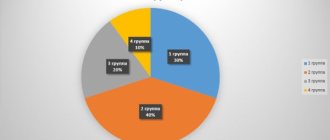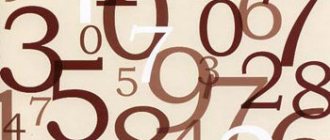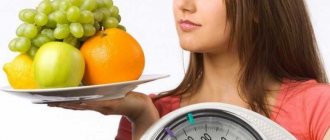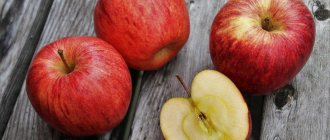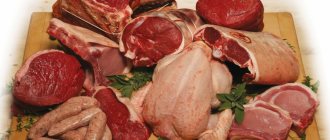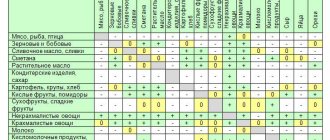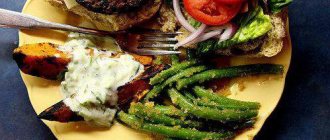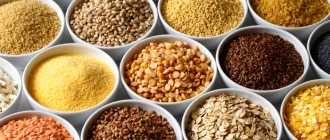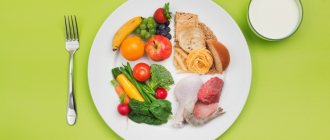What not to eat when losing weight
The formation of fat deposits occurs, as a rule, due to poor nutrition and a sedentary lifestyle. To lose excess weight, you need to stop consuming:
- Products with fast carbohydrates. They have a high glycemic index, so they are quickly absorbed, enter the bloodstream and cause weight gain.
- Roast. To achieve the desired result, you need to avoid fried foods, especially those with a lot of oil. These foods contain a lot of cholesterol. They stimulate the production of hydrochloric acid. Preference should be given to boiled and stewed dishes.
- Spicy food warms the body from the inside, that is, it activates blood flow and increases appetite. As a result, a person does not feel full, so he overeats. Garlic, ginger and hot pepper can be replaced with fresh or dried herbs. It will help make dishes more piquant. Cilantro, dill, basil and parsley will be useful.
Experts do not recommend consuming completely low-fat dairy products. When processed, all nutrients and vitamins are lost along with fat.
Who is recommended for treatment table No. 4?
Diet number 4 is prescribed for gastrointestinal problems characterized by acute pain, increased gas formation, diarrhea and other manifestations of discomfort. There are several varieties of 4 tables depending on the phase of the disease:
- 4a - chronic colitis and intestinal diseases, accompanied by diarrhea and increased flatulence. Consists mainly of proteins, the consumption of carbohydrates and fats is kept to a minimum;
- 4b - has a beneficial effect on the functioning of the liver and pancreas during exacerbations in the attenuation stage. Differs in greater variety compared to the previous version;
- 4c - is used during the recovery period and is one of the stages of the transition to a nutritious diet.

List of foods you shouldn't eat while losing weight
There are a number of products that not only prevent weight loss, but are also harmful to the entire body.
Fatty meats
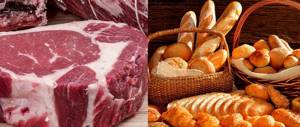
Meat is a source of protein and should be present even in the diet. But fatty pork is quite high in calories, takes a long time to digest and contributes to weight gain. 100 g of fried pork contains about 390 calories.
Bakery and flour products
Dough for baked goods is mixed with yeast, which disrupts the normal intestinal microflora. If it is difficult to completely give up white bread, it should be replaced with rye or yeast-free bread.
It is difficult for the body to digest flour. With frequent consumption of confectionery products, the body will no longer cope with the amount of incoming sugars, and begins to transform carbohydrates into fat, storing them “in reserve” in the abdomen, on the sides and thighs.
Pasta made from soft wheat varieties is a source of harmful refined carbohydrates that increase the concentration of glucose in the blood.
This leads not only to diabetes, but also to vascular depletion, and as a result, a stroke or heart attack. A sedentary lifestyle contributes to obesity.
Sweets

Sweets are empty calories that do not bring any benefit to the body. You can eat them in the first half of the day, but in small quantities. In the evening it is better to limit consumption:
- pies;
- cakes;
- cupcakes;
- cookie;
- candies.
It is recommended to drink tea and coffee without sugar or with sweeteners. And sweets can be replaced with fruit chips, natural marshmallows and marmalade.
Sweet fruits
Experts recommend giving up sweet fruits, as they contribute to excess weight gain. Prohibited:
- bananas;
- grape;
- mango;
- persimmon;
- pomegranate.
They are healthy, they contain a lot of vitamins and fiber. Any fruit can be included in your diet as a snack, but it is advisable to eat them on the day of training and before lunch.
Carbonated drinks

Sweet carbonated drinks saturate the body with extra calories. 100 ml of lemonade contains about 50 kcal.
In addition, soda contains a large number of artificial colors, flavors and other food additives, which not only prevent weight loss, but also harm the entire body.
Starchy vegetables and fruits
On a diet, vegetables and fruits high in starch should be avoided. These are complex carbohydrates that, when they enter the digestive tract, quickly break down and turn into glucose.
Starchy vegetables:
- potato;
- corn;
- peas;
- beet;
- carrot;
- beans;
- swede;
- radish;
- Jerusalem artichoke;
- radish.
If it is difficult to completely give up starchy vegetables, then they need to be properly combined with other vegetables and herbs that contain a large amount of fiber.
Porridges and cereals
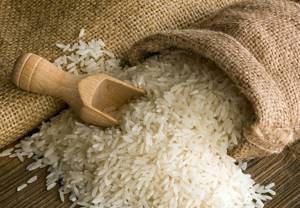
Nutritionists recommend excluding cereals and porridges made from processed grains from your diet. These are white rice, instant cereal, semolina and corn grits. Such products contain fewer nutrients and have a high glycemic index. Choose healthier porridges, such as buckwheat and oatmeal.
Semi-finished products
Ready-made semi-finished products contain a lot of salt, spices and various harmful food additives. Flavorings and dyes are added to improve the taste. Manufacturers often violate standards and use low-quality raw materials for production. Therefore, you risk not only gaining extra pounds, but also getting poisoned.
Alcohol
Alcoholic drinks have a bad effect on the condition of the skin and blood vessels. Alcohol is quickly absorbed into the blood, thereby igniting a strong appetite. Champagne and sweet wine activate the intestines, causing a feeling of hunger.
Scientists have proven that when drinking alcohol, a person absorbs much more food than usual. This is why restaurants offer aperitif drinks.
Fast food
Fast food (fast food sold on the street) is the main enemy of a slim figure. It is a source of large amounts of calories and unhealthy fats. It contains preservatives, dyes, a lot of salt and artificial additives.
Pros and cons of nutrition based on blood type
Dietary principles of nutrition according to blood groups are suitable for all people who strive to lead a healthy lifestyle and have no contraindications for health reasons. The regimen is designed for a long period (2-6 months) and has a lasting effect. The diet is balanced, it contains all nutrients in optimal proportions.
Main advantages
:
- balance;
- softness;
- a large selection of healthy products, many neutral ones;
- Infrequent consumption of prohibited foods is acceptable.
Disadvantages of the weight loss system by blood type
:
- there is no guarantee of excess weight loss;
- you need to take into account the state of the digestive system, control cholesterol levels;
- it is necessary to change taste preferences;
- high risk of failure due to prolonged dietary restriction;
- The nutritional system is based on a hypothesis and has no scientific basis.
A significant disadvantage of the diet is a large list of contraindications
:
- chronic stomach diseases;
- pregnancy and breastfeeding;
- pathology of the heart or blood vessels;
- blood diseases, diabetes, weak immunity;
- exacerbation of infectious or viral diseases.
Numerous studies in the field of nutrition prove that the Rh factor has no effect on the digestibility of food. This means that the choice of products, menu and nutritional recommendations will be the same for the first positive and first negative blood groups.
In the book “Nutrition by Blood Type,” Peter D'Adamo writes that neither the Rh factor, nor gender, nor age matter when compiling a diet. However, his next bestseller, entitled “4 Blood Types - 4 Paths to Health,” contains separate diet menus for 3 positive and 3 negative blood types. But they differ slightly.
Top 7 prohibited foods if you want to lose weight
Nutritionists believe that for effective weight loss you need to exclude only 7 harmful foods from your diet.
Strictly prohibited:
- White bread;
- pork;
- refined white rice;
- potato;
- sugar;
- pasta;
- sweets.
They are present in the diet of any person, but if you want to lose weight, eating these foods is strictly prohibited. If you strictly adhere to the principles of proper nutrition, you can already notice in a month how the extra centimeters on your waist disappear.
To avoid a breakdown and gain weight again, prohibited foods when losing weight should be reduced to a minimum or replaced with other, more healthy ones.
Nutrition according to blood group III (type B)
Type B (third blood group) is called a “nomad”. These people can eat plants and most meats (except chicken and pork), and can also eat dairy products. However, they should avoid wheat, corn, lentils, tomatoes and some other foods.
Otherwise, nutrition for the third blood group is recommended according to the principle of a carbohydrate-free diet.
Table of foods for 3 positive blood group
| Recommended Products | Neutral products | Prohibited Products |
| Mutton | Turkey | |
| Rabbit meat | Beef, veal | |
| Eggplant | Liver | Seafood |
| Broccoli | Herring | Crustaceans |
| Beet | Trout | Perch |
| Carrot | Haddock | Soybean oil |
| Pepper | Squid | Sunflower oil |
| Cabbage | Carp | Buckwheat |
| Mackerel | Asparagus | Corn |
| Salmon | Greenery | Wheat |
| Halibut | Salads | Barley |
| Pike | Potato | Rye |
| Sturgeon | cucumbers | Lentils |
| Caviar | Pumpkin | Tomatoes |
| Flounder | Garlic | Corn |
| Cod | Green pea | Pear |
| Oat groats | Pasta made from any wheat flour | Coconut |
| Rice flour pasta | Brown rice | Pomegranate |
| Rice | Whole milk | |
| Eggs | Butter | |
| Soybeans | Soy milk | |
| Beans | All fruits except those that are prohibited | |
| Beans | Any spices except allspice | |
| Low-fat cheeses | Pickles | |
| Cottage cheese | Mayonnaise | |
| Yogurt | Jam | |
| Rice cakes | Mustard | |
| Millet bread | Lemon water | |
| Ginger and curry | Coffee | |
| Banana | Red wine | |
| Apricot | White wine | |
| Plum | Jelly | |
| A pineapple | Canned legumes | |
| Green tea | Green beans | |
| Juice (almost any) | White beans | |
| Olive oil |
Menu for blood group 3
You can often hear questions about how the list of products differs for people with a third negative blood group. In fact, there are no special differences here.
All the same products are allowed, but the same products are prohibited. But here it is worth paying more attention to nutrition. Rh negative makes the body more sensitive to nutrition. It is necessary to completely eliminate prohibited foods from the diet, and also be very careful about those allowed for limited consumption.
| III positive | ||||
| Days | Breakfast | Dinner | Afternoon snack | Dinner |
| 1 | Omelet with mushrooms, 50 g of bread, coffee. | Cereal soup with lamb. | Banana, a handful of nuts, tea. | Fish stewed with vegetables, green tea. |
| 2 | Sandwich with chickpea paste, tea with lemon. | Turkey stewed with zucchini, bread. | Sheep cheese slices, herbal drink. | Salad of boiled meat, Chinese cabbage and Feta cheese, vegetable juice. |
| 3 | Sandwich of dried bread with salmon, coffee. | Borscht with sour cream, 50 g of bread. | Fruit salad with honey. | Meatballs, cabbage salad with vegetable oil, compote. |
| III negative | |||
| Days | Breakfast | Dinner | Dinner |
| 1 | Steam omelette with herbs, cappuccino. | Stewed rabbit, herbal drink. | Cottage cheese casserole with raisins, fresh fruit. |
| 2 | 2 poached eggs, vegetable smoothie. | Steamed fish, tea. | Carrot-apple puree, herbal tea |
| 3 | Sandwich of toasted bread with salmon, black tea. | Stew of chicken breast and vegetables, chamomile tea. | Fruit salad, herbal tea. |
What can be replaced
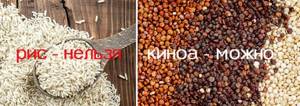
Most unhealthy foods have safer and healthier alternatives.
Instead of white bread, it is recommended to give preference to whole grain bread or products that include bran and fiber. They not only prevent excess weight gain, but also cleanse the body.
Pork and fatty meats should be replaced with leaner types: white meat or fish. It can be chicken, rabbit, turkey, beef.
A great alternative to white rice is quinoa. This grain crop contains large amounts of protein and amino acids. Porridge has a low glycemic index, so it is efficiently processed and provides the body with energy.
Potatoes contain a large amount of starch. It is recommended to replace it with peas. It is a source of zinc, copper, vitamins A, PP and E.
A useful analogue of sugar is honey; it is quite high in calories, but it contains many microelements that are beneficial for the body. Less calorie fructose, stevia and synthetic sweeteners.
REFERENCE
Fructose does not increase blood sugar levels, so it is recommended for diabetics.
How many kilograms can you lose
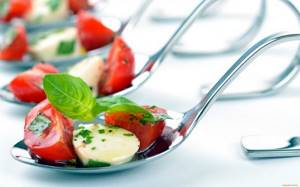
It is difficult to answer the question unambiguously, since everything depends on the initial data. The more excess weight you have, the more you can lose. You should understand that it is important not only to lose weight, but also to maintain the results obtained and, most importantly, health. The following recommendations will help reduce the negative impact of the five tablespoons diet:
- Make a menu in advance, calculate the contents of the food supply, purchase all the necessary products. This will help you avoid unplanned meals. In addition, the diet should be made according to the 80/20 principle. 80% are healthy, nutritious foods, and 20% are favorite, but conditionally prohibited foods.
- Buy an electronic kitchen scale and weigh every meal. Tablespoons can be different, but this way you can accurately track the serving size.
- Monitor the ratio of proteins, fats and carbohydrates. This is important for health, good appearance, skin, hair, and nails.
- Drink about 1.5-2 liters of clean drinking water daily.
- Gradually moves to small portions: start with 8-10 spoons, reducing portions every 5-7 days as you get used to it.
- You can reduce the likelihood of constipation or flatulence by consuming two tablespoons of fiber or oat bran with kefir every day.
But the main thing is to carefully monitor your well-being throughout the entire time. If any symptoms unusual for the body, malaise, or weakness occur, immediately stop the diet and consult a specialist for advice.
What foods should not be eaten together?
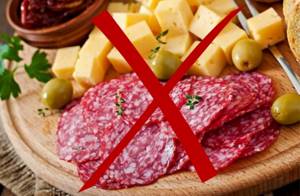
When losing weight, you need to pay special attention to creating the right menu. There are a number of products that cannot be combined with each other. Main pairs:
- Meat and cheese . Cheese contains phosphorus, and meat contains zinc. These two elements take part in metabolic processes, while phosphorus interferes with the normal absorption of zinc.
- Pasta and meat. You can combine them, but this combination is quite difficult for the stomach and can cause bloating, fermentation and flatulence.
- Eggs and potatoes. Eggs are a source of iron and calcium. Microelements present in potatoes interfere with their absorption.
- Alcoholic drinks and vegetables. Alcohol makes it difficult to absorb vitamins.
- Fish and eggs. Fatty fish is a source of large amounts of vitamin B7, but ovidin, which is found in eggs, neutralizes its positive effects.
- Tomatoes and white cheese. This combination is harmful to joints. Acids from tomatoes react with calcium, which leads to the formation of deposits in the joints, which can cause severe pain.
- Cucumbers and tomatoes. The ascorbic enzyme present in cucumbers neutralizes the effect of vitamin C contained in tomatoes.
- Tea and baked goods. Tannins from tea interfere with the normal absorption of protein, magnesium, iron and zinc.
- Pasta and tomato sauce. Starchy carbohydrates should not be combined with acidic foods.
- Banana and milk. This compound causes a feeling of heaviness and slows down the digestive tract.
Products for preparing dishes must be selected so that they are combined not only in taste. It is important that they do not neutralize vitamins and nutrients.
To lose weight, you need to review your usual diet in order to completely eliminate and replace harmful and prohibited foods. The diet should be complete, balanced and healthy.
Consult with a nutritionist, consult an endocrinologist; perhaps, to become slim, it will be enough just to remove foods from your diet that you should not eat when losing weight.
Nutrition according to blood group II (type A)
Type A (second blood group) is called agrarian or “farmer”. They are described as somewhat hysterical people who are able to get rid of excessive stress solely through the transition to vegetarianism and a complete refusal of meat.
Nutrition for blood group 2 is divided into two types: for 2 negative and 2 positive. Each of them has its own rules and nuances of application.
The second negative blood group has its own characteristics. Its owners are characterized by the presence
:
- high production of the hormone cortisol during anxiety;
- thick blood that provokes the formation of blood clots;
- fat deposits.
This situation arose when grain became the main food instead of meat. The body had to rebuild, change the digestive system. At the same time, the absorption of animal proteins - dairy products, meat - has worsened.
The menu for every day should include
the following components:
- fresh, thoroughly washed vegetables;
- porridge (but not with milk!);
- legumes;
- freshly squeezed vegetable and fruit juices (preference is given to juice from celery, apples and carrots);
- Dinner can be varied with a glass of quality red wine.
Table of products for blood group 2 negative
| Recommended Products | Neutral products | Prohibited Products |
| Turmeric | Almonds and almond paste | Mango |
| Blueberry | Chilim (water chestnut) | Lima beans |
| Ready mustard (without wheat flour) | Savory | Partridge meat |
| Miso | Seeds | Goose meat |
| Escarole | Bergamot | Calf liver |
| Okra | Baker's yeast | Coconut oil |
| Chanterelles | Chervil | Shad |
| Pumpkin seeds | Paprika | Carrageen |
| Ginger (fresh) | Guava juice, guava | Teff |
| Sardine | Maranta | Pepper (chili, ground, peas, yellow, green, red) |
| Peas (cow) | Logan berry (blackberry and raspberry hybrid) | Gum arabic |
| Artichoke pasta | Carambola | Castor oil |
| Carp | Raisin | Yucca |
| Cranberry | Kiwi | Edam cheese |
| Olive oil | Quince | Banana |
| Apricot juice | Black elderberry | Eggplant |
| Apricots | Strawberries | cucumbers |
| Parsley | Nectarine, nectarine juice | Cabbage |
| Spinach | Apples, apple juice | Potato |
| Lemons (Lemon juice) | Eggs (chicken, quail) | Apple vinegar |
Products for blood group 2 positive for every day are slightly different from blood group 2 negative, and include the following list of products:
- any soy dishes;
- as a dessert, it is allowed to add jam and homemade marmalade to the diet;
- a large amount of fresh fruits and vegetables;
- any products containing large amounts of vitamin A.
With a positive blood group of 2, any sour, spicy, salty, smoked and fried foods are strictly unacceptable! Consume sweets in minimal quantities.
Table of foods for blood group 2 positive
| Recommended Products | Neutral products | Prohibited Products |
| Salmon | Turkey | Beef |
| Fresh herring | Broiler chickens | Veal |
| Trout | Chick | Mutton |
| Mackerel | Chicken eggs | Ham |
| Pumpkin seeds | Seaweed | Pork |
| Peanut | Smelt | Rabbit meat |
| Soy/black beans | Pike | Duck |
| Spotted beans | Kefir | Catfish |
| Soy milk | Goat milk | Squid |
| Rice wafers | Processed cheese | Pickled herring |
| Buckwheat and flour | Homemade cottage cheese | Whole milk |
| Rye bread | Sour cream | Ice cream |
| Mushrooms | Margarine | Cream |
| Broccoli | Soybean oil | Milk serum |
| Onion | Sunflower oil | Pistachios |
| Carrot | Almonds/walnuts | Navy beans |
| Swiss chard | Pod peas | Bakery products |
| Spinach | Black Eyed Peas | Mayonnaise |
| Pineapples | Barley/pearl barley | Black pepper |
| Cherry plum | Corn starch | Vinegar |
| Cherry | Corn | Oranges |
| Grapefruit | Rice | Bananas |
| Lemon | Bay leaf | Tangerines |
| Apples | Nutmeg | Olives |
| Prunes | Parsley | Coconuts |
| Juices from berries/fruits | Pepper curry | Tomato juice |
| Herbal teas | Dill | Cognac, vodka |
| Green tea | Brussels sprouts | Beer |
| Black coffee | Avocado | Black tea |
Based on the table of products, it is easy to create a menu yourself.
Sample menu for 3 days
:
| Breakfast | Dinner | Dinner | |
| First | cottage cheese – 180 g, green tea | pumpkin soup – 250 g boiled fish – 160 g | buckwheat porridge, carrot salad – 150 g each, kefir |
| Second | millet porridge – 150 g, rosehip decoction | chicken breast – 200 g, boiled asparagus – 150 g | fruit salad – 300 g |
| Third | cottage cheese – 150 g, carrot juice | vegetable stew – 200 g boiled rice – 160 g | baked fish – 250 g, carrot salad – 150 g, kefir |
Tablespoons or scales?

The main rule of the diet is to consume no more than five tablespoons of the product at a time. But many people understand that there are different spoons; you can use them with or without a slide. Therefore, in many cases, such accounting may be erroneous and lead to an excess of calories. How to be?
- Get a digital kitchen scale. Limit the size of each portion not only to spoons, but also to weight - consume about 150-200 g of food at a time.
- If you don't have a kitchen scale, you can use a cut glass. Of course, this method of weighing also has an error, however, it is quite small. It is recommended to consume no more than half a glass at a time.
- An old, well-known way to determine portion size is with your fists: each meal should be no larger in volume than a clenched fist.
The main task of this nutrition system is to teach a person to eat often, in small portions. It can be used as a way to switch to a fractional diet, but provided that the process is monitored by specialists. It is important that the new rules do not harm the body or lead to serious, irreparable consequences.
How to cook them
When planning your diet, follow the “plate rule.” Mentally divide a standard plate into two parts. Divide one half into two more parts. As a result, your plate will be divided into 3 parts. One big and two smaller.
Most of it should be vegetables . These products can be prepared in different ways. It is not forbidden to boil, stew, bake, or steam them.
The best way is, of course, to eat vegetables raw.
The raw product contains a lot of pectin and fiber. These substances help cleanse the intestines and reduce cholesterol levels. They also support the normal functioning of the intestinal flora. The healthiest thing to do is eat the salad immediately after preparing it.
The second part of the plate is complex carbohydrates . You need to start your meal with vegetables. Then move on to carbohydrates. It can be porridges: buckwheat, rice, barley, etc. Durum wheat pasta, wholemeal bread.
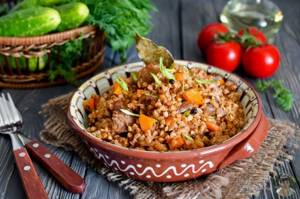
Complex carbohydrates will fill you up very quickly and will also take a long time to break down in the stomach. It is better to steam porridge rather than boil it. About
How to eat vegetables to lose weight
So we figured out what vegetables you need to eat and how many of them should be on the plate. Here I want to give some recommendations for combining them with other products.
- If you snack on salad or even replace dinner with it, no bread. Vegetables as a snack with bread cease to be a dietary dish. A small piece of whole grain bread can only be eaten for lunch or breakfast.
- Some people believe that if you eat pasta and raw vegetables, you will not gain weight. This is not true, calories from pasta will not go anywhere. Especially if you eat pasta in large portions.
- It is better to cook vegetables with their skins on and not overcook them. The best option is to cook for 15 minutes. Those. the product should be slightly undercooked.
- Vegetables should be eaten as a side dish. Those. there should be more of them on the plate than other foods. Try to snack on raw vegetables. Design your menu in such a way that 2/3 of your daily intake of vegetables consists of non-starchy foods.
- If you suffer from constipation, it is better to eat raw vegetables often and in large quantities. These foods are rich in fiber and clean the intestines like a brush. This way you will restore intestinal motility and lose weight.
And how many delicious dishes can be prepared from vegetables! Lose weight with pleasure and be healthy. Don't forget about updates, be sure to subscribe. Bye everyone.
Sincerely, Olga Steshkina
Results and reviews of the 5 tablespoons diet
On the Internet you can find many reviews on the diet, before and after photos. What positive things do people who lose weight note?
- relative dietary diversity;
- the ability to include your favorite dishes on the menu.
There are many more disadvantages:
- constant feeling of hunger;
- the need to prepare food every day to take with you;
- deterioration in health;
- decreased concentration and performance - which is especially bad for working people.
Summarize. The five tablespoons diet can be used, but in a lighter, more adapted form. Experienced specialists, whose help should not be neglected, will help you to correctly compose a diet, select calorie content and the ratio of BJU.
Preparing for the diet and getting started
Switching to a new type of diet in one day can be extremely difficult. People who are losing weight often face the following problems:
- constant feeling of hunger;
- decreased concentration;
- mood measurement, apathy, depression;
- changes in the condition of the skin, hair, nails;
- general malaise.
All problems are caused by a lack of vitamins, minerals and nutrients. The negative impact can be somewhat reduced if you gradually move to a new power system. A few simple rules will help:
- Step by step. Reduce portion sizes day by day until they reach 150-200 grams. It is better to start 2-3 weeks before the expected start of the diet.
- Prepare food at home, take it with you in containers to school or work. This will help you avoid unplanned snacks.
- Keep a food diary, record meal times, portion sizes, and calculate the KBJU ratio.
A gradual and smooth transition will help the body adapt and adapt more easily to new conditions.
